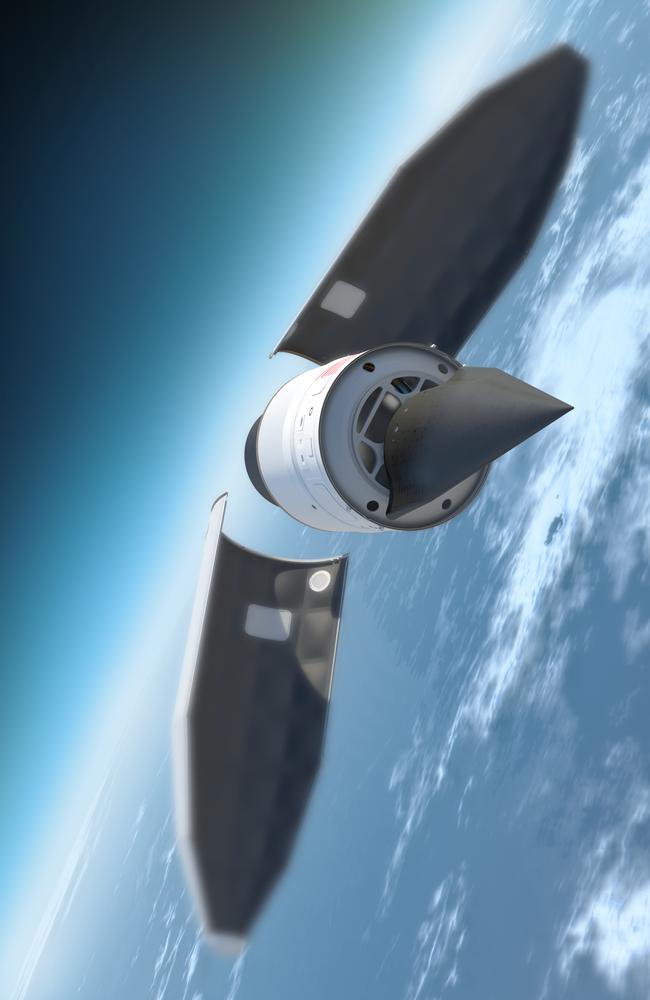US Air Force spends $1 billion to speed up hypersonic missile program
THE US Air Force has rushed out a $1 billion contract to catch up with China and Russia, as hypersonic weapons threaten to reshape the modern battlefield.
MISSILES that fly over five times the speed of sound.
It’s a sobering thought.
So, too, is the fact that both China and Russia are boasting they have successfully completed their development programs for the new technology — and have production lines rolling out the new weapons now.
The United States Air Force now appears to be taking these claims seriously.
It has just handed Lockheed Martin $US928 billion ($A1.2 billion) to get its own version off the ground.
Wonder what weapons of the future #SkunkWorks is working on? Catch the highlights on the “Emerging Technologies†episode of the @AirForceAssoc podcast: https://t.co/9Kauw61LlE pic.twitter.com/os2oFyr5DS
— Lockheed Martin (@LockheedMartin) April 20, 2018
RELATED: Here’s the US Air Force’s vision of the future
What it has asked for is an air-launched stand-off hypersonic missile capable of dodging — and speeding — through hostile defences.
“This effort is one of two hypersonic weapon prototyping efforts being pursued by the Air Force to accelerate hypersonics research and development,” Air Force spokeswoman Ann Stefanek says in a statement. “The Air Force is using prototyping to explore the art-of-the-possible and to advance these technologies to a capability as quickly as possible.”

KILL VEHICLE
Hypersonic weapons threaten to turn the modern battlefield upside down.
For decades, militaries have been depending on fast computers, snappy radars and rapid-fire guns and missiles to shoot-down incoming missile threats.
Now, that missile threat has leapfrogged ahead.
At more than 6000km/h, such a missile doesn’t even need an explosive warhead.
Its speed, combined with its mass, makes it a large meteor with the potential to devastate.
And there’s little that can be done to stop one.
EXPLORE MORE: China just put a hypersonic rail gun on a warship
Computer-guided gatling guns, such as the Phalanx systems fitted to US and Australian ships, most likely don’t pack enough punch to turn one from its path — if they can even hit it.
And point-defence missile systems such as the Evolved Sea Sparrow will also struggle to reach the right place at the right time to make any difference.

RUSH JOB
The contract to “design, development, engineering, systems integration, test, logistics planning, and aircraft integration support of all the elements of a hypersonic, conventional, air-launched, stand-off weapon” was issued last week.
Lockheed Martin has been given no deadline to produce results. But it also hasn’t yet been given any guarantee the USAF will buy any.
Other US hypersonic programs, co-ordinated by the Defense Advanced Research Projects Agency (DARPA) include the Tactical Boost Glide program and the Hypersonic Air-breathing Weapon Concept (HAWC).
DELVE DEEPER: Here are Putin’s six new ‘superweapons’
US Undersecretary of Defense and Research Michael Griffin has been critical of his nation’s slow pace of advancement in this emerging field.
“The most significant advance by our adversaries has been the Chinese development of what is now today a pretty mature system for conventional prompt strike at multi thousand kilometre ranges,” Griffin told the House Armed Services Committee. “We will, with today’s defensive systems, not see these things coming.
“It is time for us to renew our emphasis on and funding of these areas in a co-ordinated way across the department to develop systems which can be based on land for conventional prompt strike, can be based at sea, and later on can be based on aircraft.”




